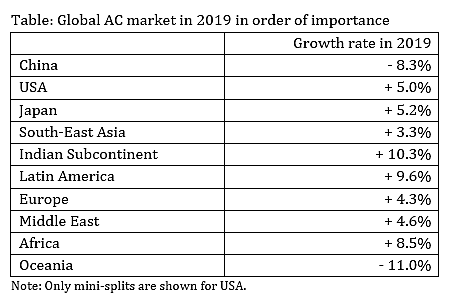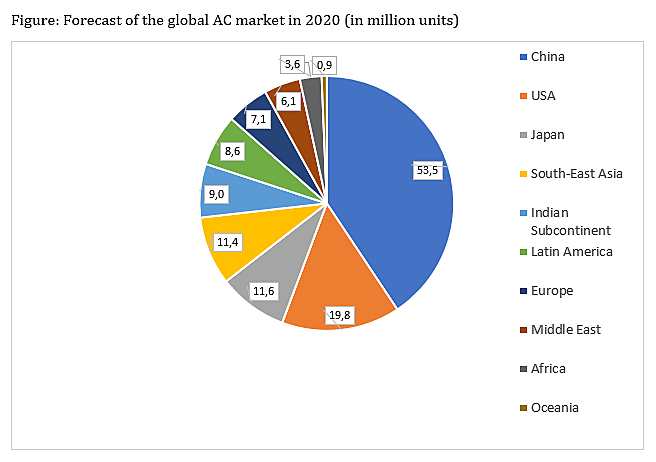World air-conditioning market in 2019
Despite a decline of -0.8% in sales globally, many markets performed well in 2019. Inverter technology and smart air conditioners are steadily gaining ground globally while sales of R32 systems are increasing mainly in Asia.
According to the January 2020 issue of JARN, the decline observed in the world air-conditioning market in 2018 has continued in 2019 [1]. A 0.8% decrease was observed, with a volume of sales of 130.7 million units.
The table below details the evolution of this market in 2019 compared to 2018 by region of the world.

With 54.6 million units sold in 2019, the Chinese market remains by far the largest in the world, representing 41.8% of the global market size. Hence, its year-on-year decline of 8.3% affects global sales figures for 2019. Yet, other markets performed well in 2019 and almost all air conditioner (AC) manufacturers registered very good sales.
Moreover, JARN anticipates for 2020 a moderate increase of 0.7% in 2020, corresponding to a sales volume of 131.6 million units. Details of planned sales by region are provided in the pie chart below.

Penetration of inverter technology
The cost of electricity continues to boost inverter AC as an energy-saving alternative. Supported by revised national energy standards in various countries encouraging their use, inverter ACs are gaining popularity in China, Southeast Asia and India.
In China, inverter ACs accounted for 64.7% of the split-type room AC market. Most likely, non-inverter AC will be phased out of the Chinese market by 2022.
In Thailand, penetration of inverter AC exceeded expectations for 2019, reaching 65%. Likewise, in Vietnam, inverter ACs have a market share of more than 60%. Such figures are well above the penetration rate in surrounding countries, except for Singapore where the penetration rate is above 90%.
In India, inverter models showed the highest growth among all ACs technology, accounting for 55% of the split-type room AC market. Inverter AC technology has been steadily growing in India, with market shares of 15% in 2017 and 35% in 2018 [2].
In Brazil, the largest market in Latin American, there is a demand for inverter models due to high electricity prices. Inverter models account for 45% of the split-type room AC market in Brazil.
Conversely, in the USA, the proportion of inverter ACs remains low. Nevertheless, 1.25 million mini-split AC units have been installed in 2019, most of which are inverter models. This is unprecedented in the history of air conditioning in the USA.
Smart ACs
Given the aging population in Western countries, air conditioning now plays a role in safeguarding the health of the elderly. In addition, the development of fifth generation (5G) wireless internet has also opened more possibilities for the air conditioning industry.
Consequently, air conditioners integrating artificial intelligence (AI) as well as Internet of Things (IoT) technologies are on the rise.
In Japan, now that the market is fully saturated with energy-saving models, there is a demand for models incorporating AI. Almost all high-end products sold in 2019 featured AI functions such as humidity control, automatic cleaning, remote control with a smartphone, etc.
Refrigerant trends
In EU countries, R32 room ACs and packaged ACs now account for about 60% and 30% of the AC market respectively.
In Japan, R32 systems are widespread. Southeast Asia, Australia and India have accelerated a shift to R32 in 2019 albeit to a much lesser rate than Japan. In the major Southeast Asian countries, a large portion of the mainstream cooling-only splits driven by R22 have been replaced with R410A and R32 models, except in the Philippines.
There are currently no full-scale sales of R32 systems planned in Latin America, where R22 ACs are still predominant.
In Africa, R22 units also predominate, except in South Africa and Algeria where the AC markets have shifted to R410A.
Sources:
1. JARN, January 25, 2020
2. World air-conditioning market: figures and technical trends.
